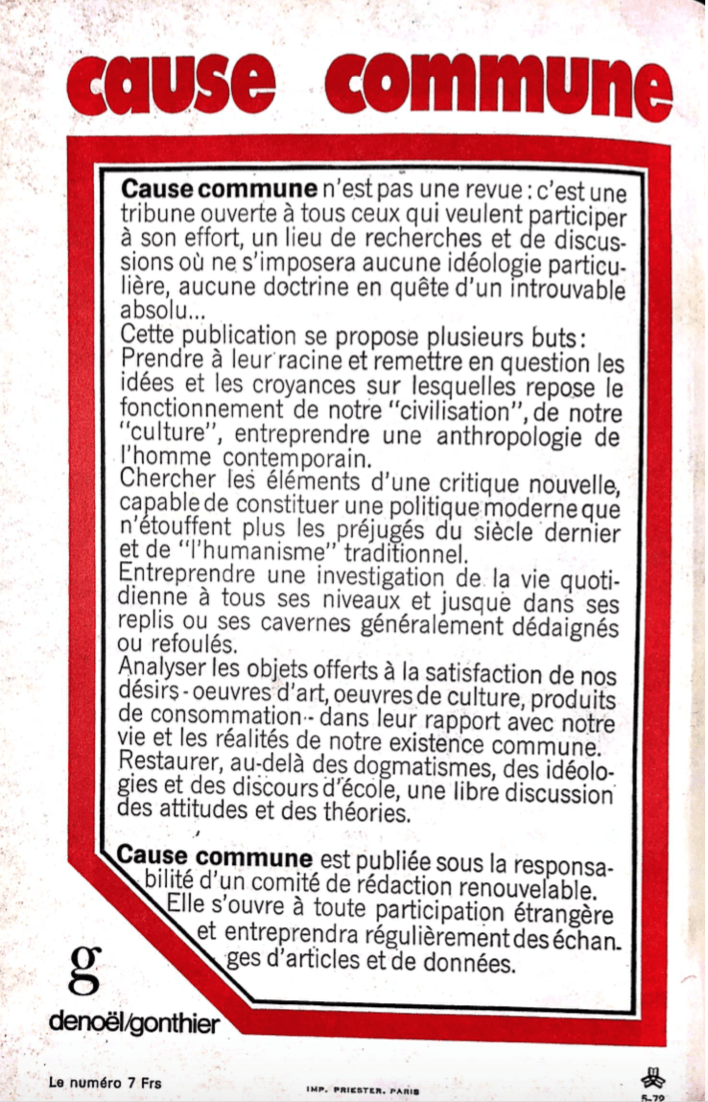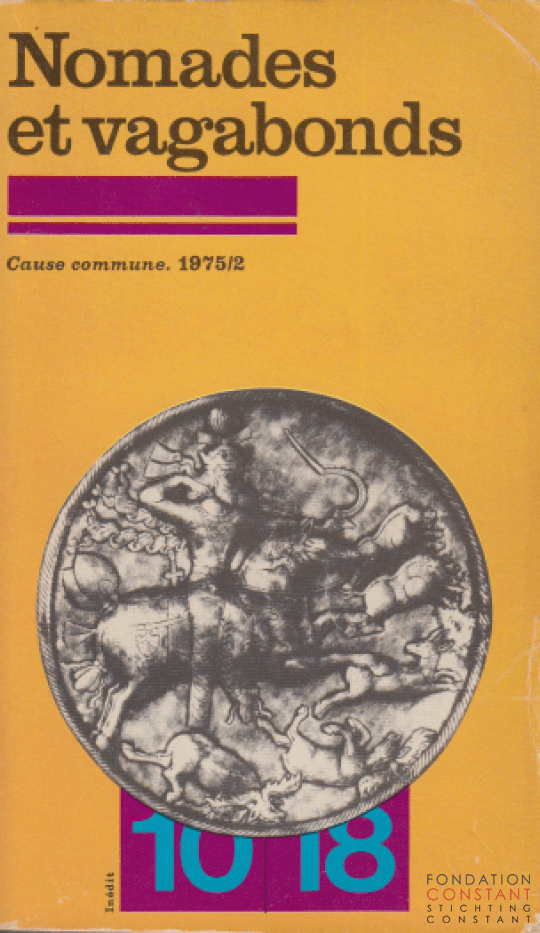By Anne Schult

In 1972, the same year Clastres published his seminal La société contre l’état, the interdisciplinary collective Cause commune began issuing a quarterly journal of the same name under the editorship of sociologist Jean Duvignaud. Publishing only nine volumes within the span of two years and a few additional stand-alone paperbacks through the latter 1970s, Cause commune was ephemeral in nature and proclaimed itself not to be a journal but rather an “open tribune.” The project was devoted to chronicling the quotidian in all its facets, and eager to discover resistance to and freedom from “the system” in everyday interactions without being indebted to any particular ideology. In its prosaic world, nomads emerged as a more diffuse metaphor that became increasingly detached from prehistoric nomadism. Rather than sticking to scientific definitions, the journal’s contributions drew on the long association of nomads with danger and disruption in the European imaginary: the nomadic thus encompassed pastoralists and pilgrims, certainly, but also vagabonds, outcasts, and criminals. Accordingly, nomadic elements were mapped onto individuals, rather than societal organization at large, and their experiences and practices vis-à-vis the contemporary state.

Although nomads were an occasional reference point throughout the journal’s early contributions, it was not until the thematic collection Nomades et vagabonds (1975) that it became firmly established as a key concept of the subversive contemporary. Duvignaud, opening the volume with his essay “Esquisse pour le nomade,” set the agenda by opposing modern urbanity, with its walls and murals, with the vast “empire of the steppes” (16) of the nomadic outside the city borders. Though clearly a play on historic nomads—alluding, as it did, to René Grousset’s L’Empire des steppes (1939), a history of Central Asia—Duvignaud’s exposition made it clear that he was not interested in interpretations of said nomads as distant origins of present society, but rather in the underlying principle of mobility that had survived its now extinct archetype. Indeed, he wrote, “one should not establish a historical relationship of ‘before’ and ‘after’ between the nomad and the sedentary civilization” (35), which effectively created temporal othering.

Instead, Duvignaud suggested that the nomadic had merely been internalized in the present, which becomes particularly apparent when reading his thoughts on nomads alongside his prior work L’Anomie, hérésie et subversion (1973). Here, Duvignaud positioned the anomic as an inherent source of individual creativity that is stifled by the process of normalization taking place in centralized society. His anomic individual, a “personnage inclassable” similar to the nomad, has no allegiance to any system. Always on the verge of being incorporated in, explained, and subdued by state institutions and history, it yet manages to challenge rigid structures by opposing them with unfulfilled desire. Indeed, the deviant personality of L’Anomie and the nomad in Nomades et vagabonds can be understood as different figurations of the same idea, suggesting a direct link between the rise of nomadism as a concept and the philosophy of desire flourishing in France around the same time.
Duvignaud’s colleague and fellow sociologist Jacques Berque, meanwhile, proposed a tentative identification of the colonial/postcolonial subject with the nomadic in his contribution to Nomades et vagabonds. In his autobiographical essay “Entrée dans le bureau arabe,” Berque chronicled life among rural Moroccan herders as a colonial administrator in the 1940s. Offering a somewhat nostalgic reading of the pastoral lifestyle in the High Atlas, he described in detail how the French colonial administration imposed its legal system and pushed economic reforms to gain control of the Maghreb. Yet, as he noted, the “bureau arabe” remained remarkably out of sync with the reality of the population, which was constantly in flux and modernizing by itself at a different pace.
Indeed, this article fit into Berque’s larger project of reclaiming a nomadic heritage for contemporary Islamic society in the former colonies of North Africa. Having left the historical desert Bedouin behind, Berque argued in his own book Langages arabes du présent (1974), Arab nomadism had been driven inwards, in no small part due to the imposition of colonialism, but was still detectible in the culture, literature, and mentality of the contemporary Arab world. Critical of continued Western political interference in Africa and Asia after the fall of the French Empire, Berque generally emphasized the shape-shifting, adaptive nature of the postcolonial societies in their attempts to modernize vis-à-vis a French politics that was rigid and clinging to the past. While it is thus true that in the 1970s French thought, the figure of the nomad often rested in an uneasy, ambiguous position in relation to real-life mobility, it would be inaccurate to claim that it was entirely ignorant of it. As Berque illustrated, the geographies of nomadism did map onto the geographies of the postcolonial world, whether these were real or imagined.
Similar to Berque, philosopher Paul Virilio engaged the idea of the nomadic as a difference in tempo in his contribution to Nomades et vagabonds. However, rather than celebrating speed, he critically analyzed the state’s attempted appropriation of this once nomadic characteristic. In his essay “Véhiculaire,” Virilio specifically focused on vehicles of transmission, e.g. automobiles and telephony, which had sped up transport and communications in modernity. For Virilio, however, this was a moment of relative movement, because the technology-assisted acceleration of human life was simultaneously immobilizing individuals’ bodies and slowly eradicating embodied experience. What is more, these new technologies did not primarily create freedom but rather dependence, both on the machinery itself and on the state, which was most often administering these technologies in the public sphere.
Though Virilio agreed with the description of the modern subject’s gradual return to nomadism with the rise of technology—an idea tightly linked to the work of Marshall McLuhan—he saw this newfound mobility not as a true revival but as empty and artificial. Technology-driven mobility might have mimicked true nomadism, he asserted, but essentially remained without purpose. Exploring the dark side of McLuhan’s optimistic neo-primitivism, Virilio described such state-appropriated nomadism as a feedback loop that negated any narrative of progress and alienates the modern individual. In contrast to Duvignaud and Berque, then, Virilo’s critical understanding of technological modernity exhibited a curious scenario of nomadism “gone wrong,” suggesting that a strict distinction between the nomad and the state in the vein of a historical mobile-sedentary dualism was no longer accurate or sufficient.
***
This piece marks the second installment in a three-part series on nomads and the nomadic in 1970s French thought. The first part explored anthropologist Pierre Clastres’ projection of nomads as an alternative, more egalitarian society within prehistory that had been lost due the rise of the capitalist state. The third part traces how the nomad arose as a more metaphorical element to describe and criticize contemporaneous state repression of mobility over the course of the 1970s.
Anne Schult is a PhD student in the History Department at New York University. Her current research focuses on the intersection of migration, law, and demography in 20th-century Europe.
Featured Image: Cover art of Jean Duvignaud’s L’anomie: hérésie et subversion, Éditions anthropos (1973).




March 6, 2019 at 4:42 pm
Superb analysis. As an artist working in multiple fields all my life on incomes below the poverty line and without ever owning a home, I wonder whether any French philosopher applied this notion of nomadism to the life of the unaffiliated artist.